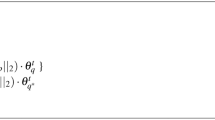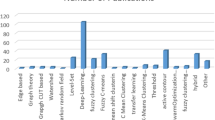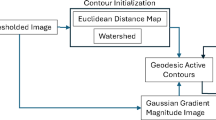Abstract
In this paper, we propose a fast multistage hybrid algorithm for 3D segmentation of medical images. We first employ a morphological recursive erosion operation to reduce the connectivity between the object to be segmented and its neighborhood; then the fast marching method is used to greatly accelerate the initial propagation of a surface front from the user defined seed structure to a surface close to the desired boundary; a morphological reconstruction method then operates on this surface to achieve an initial segmentation result; and finally morphological recursive dilation is employed to recover any structure lost in the first stage of the algorithm. This approach is tested on 60 CT or MRI images of the brain, heart and urinary system, to demonstrate the robustness of this technique across a variety of imaging modalities and organ systems. The algorithm is also validated against datasets for which “truth” is known. These measurements revealed that the algorithm achieved a mean “similarity index” of 0.966 across the three organ systems. The execution time for this algorithm, when run on a 550 MHz Dual PIII-based PC runningWindows NT, and extracting the cortex from brain MRIs, the cardiac surface from dynamic CT, and the kidneys from 3D CT, was 38, 46 and 23 s, respectively.
Similar content being viewed by others
Explore related subjects
Discover the latest articles, news and stories from top researchers in related subjects.References
Bedzek JC, Hall LO, Clarke LP (1993) Review of MR image segmentation techniques using pattern recognition. Med Phys 20(4):1033–1048
Frangi AF, Niessen WJ, Viergever MA (2001) Three-dimensional modeling for functional analysis of cardiac images:AReview. IEEE Trans Med Imaging 20(1):2–25
Awcock GJ, Thomas R (1996) Applied image processing. McGraw-Hill, New York
Rajapakse JC, Giedd JN, Rapopart JL (1997) Statistical approach to segmentation of single-channel cerebralMRimages. IEEE Trans Med Imaging 16(2):176–186
Kass M, Witkin A, Terzopolous D (1988) Snake: active contour models. Int J Compt. Vis 1:321–331
Osher S, Sethian JA (1988) Fronts propagating with curvature dependent speed: algorithms based on Hamilton.Jacobi formulation. J Comput Phys 79:12–49
Sekiguchi H, Sano K, Yokoyama T (1994) Interactive 3-dimensional segmentation method based on region growing method. Syst Comput Jp 25(1):88–97
Vincent L (1993) Morphological grayscale reconstruction in image analysis: applications and efficient algorithms. IEEE Trans Image Process 2(2):176–201
Vincent L, Soille P (1991)Watersheds in digital spaces: an efficient algorithm based on immersion simulations. IEEE Trans Pattern Anal Mach Intell 13(6):583–598
Cheng F, Venetsanopoulos AN (2000) Adaptive morphological operators fast algorithms and their aplications. Pattern Recognit 33:917–933
Bieniek A, Morga A (2000) An efficient watershed algorithm based on connected components. Pattern Recognit 33:907–916
Gu L, Peters T (2004) Robust 3D organ segmentation using a fast hybrid algorithm. In: Proceedings of 18th international congress and exhibition on computer assisted radiology and surgery(CARS2004), pp. 69–74, June 2004
Yezzi A, Kichenassamy S, Kumar A, Olver P, Tannenbaum A (1997) A geometric snake model for segmentation of medical imagery . IEEE Trans Med Imag 16(2):199–209
Atkins MS, Mackiewich BT (1998) Fully automatic segmentation of the brain in MRI. IEEE Trans Med Imaging 17(1):98–107
Audette MA, Peters TM (1999) Level-set segmentation and registration for computing intrasurgical deformations. In: Proceedings of SPIE 3661 medical imaging 1999, pp 110.121
Bomans M, Hohne K-H (1990) 3D Segmentation of MR images of the head for 3D display. IEEE Trans Med Imaging 9(2):177–183
Macdonald D, Kabani N, Avis D, Evans AC (2000) Automated 3D extraction of inner and outer surfaces of cerebral cortex from MRI. NeuroImage 12:340–356
Snel JG, Venema HW, Grimbergen CA (2002) Deformable triangular surface using fast 1-D radial lagrangian dynamics. segmentation of 3D MR and CT image of the wrist. IEEE Trans Med Imaging 21(8):888–903
Chalana V, Linker DT, Haynor DR, Kim Y (1996) A multiple active contour model for cardiac boundary detection on echocardiograpgic sequences. IEEE Trans Med Imaging 15(3):290–298
Choi SM, Lee JE, Kim J, Kim MH (1997) Volumetric object reconstruction using the 3D-MRF model-based segmentation. IEEE Trans Med Imaging 16(6):887–892
Leemput KV, Maes F, Vandermeulen D, Suetens P (1999) Automated model- based tissue classification of MR images of the brain. IEEE Trans Med Imaging 18(10):897–908
Sethian JA (1999) Level set methods and fast martching methods. Cambridge University Press
Serra J (1982) Image analysis and mathematical morphology. Academic Press, London U.K
Haralick RM, Shapiro LG (1992) Computer and robot vision. vol 1, Addison-Wesley Press, Reading
Kwan RKS, Evans AC, Pike GB (1999) MRI simulation-based evaluation of image processing and classification methods. IEEE Trans Med Imaging 18(11):1085–1097
Zijdenbos AP, Dawant BM,Margolin RA, Palmer AC (1994) Morphometric analysis of white matter lesions in MR images: method and validation. IEEE Trans Med Imaging 13:716–724
Gu L, Kaneko T (2000) Extraction of organs using threedimensional mathematical morphology. Syst Comput Jpn 31(7):29–37
Author information
Authors and Affiliations
Corresponding author
Rights and permissions
About this article
Cite this article
Gu, L., Peters, T. 3D Segmentation of Medical Images Using a Fast Multistage Hybrid Algorithm. Int J CARS 1, 23–31 (2006). https://doi.org/10.1007/s11548-006-0001-4
Published:
Issue Date:
DOI: https://doi.org/10.1007/s11548-006-0001-4




